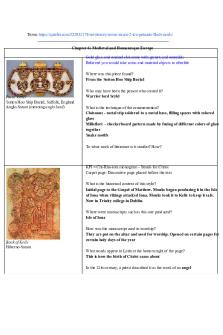Exam 2 Study Guide PDF

| Title | Exam 2 Study Guide |
|---|---|
| Course | Introduction to Forensic Science |
| Institution | Utah Valley University |
| Pages | 3 |
| File Size | 62.1 KB |
| File Type | |
| Total Downloads | 46 |
| Total Views | 171 |
Summary
Study guide for intro to forensics....
Description
1. What is the first fundamental principle of fingerprints? ● A fingerprint is an individual characteristic because no two fingers have yet been found to possess identical ridge patterns.
2. What are the three types of fingerprint patterns? Which is most common? ● ●
Loops, arches, and whorls. Loops is the most popular.
3. What is a latent fingerprint? Briefly describe how a latent fingerprint is formed. ●
Invisible or barely visible and requires development. Formed because each skin ridge is populated with pores leading to sweat glands, from which perspiration is deposited on the skin. Perspiration and oils transfer onto touched surfaces.
4. Name the three kinds of crime-scene fingerprints. ● ● ●
Latent: Invisible or barely visible and requires development Patent: Visible to the naked eye Plastic: Three-dimensional
5. Name four common chemical methods for visualizing latent prints. ●
Super glue, iodine fuming, ninhydrin, physical developer.
6. What is the first thing that the criminalist must do after visualizing a print but before making any further attempts at preserving it? ●
Take photographs.
7. It is estimated that there are how many ridge characteristics in an average complete fingerprint? a. 50 b. 100 c. 150 d. 200 8. To permanently alter his or her fingerprint and produce scars, a person must damage what? a. Minutiae b. Ridges c. Epidermis d. Dermal papillae
9. The three types of fingerprint patterns are loops, whorls, and arches.
10. The analysis, comparison, evaluation, and verification of a fingerprint is known as ACE-V. CHAPTER 9 REVIEW QUESTIONS
1. What is rifling and what is its purpose? Impressing the inner surface with spiral grooves, it guides the bullet through the barrel. 2.
How are striations useful for comparing bullets? They’re the individual characteristics of the barrel.
3.
What is the firearms examiner’s most important tool and why is it so important? The comparison microscope.
4. What parts of a firearm leave impressions on a cartridge case that constitute individual characteristics of that weapon? extractor, ejector, firing pin, and breechblock 5.
What is distance determination and upon what is it based? Distance determination: the distance from which a handgun or rifle has been fired based on means of comparison of the powder-residue pattern located on the victim's clothing or skin against test patterns made when the suspect weapon is fired at varying distances from a target 6. What is choke? How is it related to the speed, range, and spread pattern of shotgun pellets? Choke is the interior constriction of a shotgun bore at the muzzle for the purpose of controlling the pattern of the fired shot. Speed is faster, range is further, and the spread pattern is narrower. 7. What is the Greiss test? What substance is being tested for in this procedure? The Greiss test is a chemical test that can detect gunpowder resides that are not visible, it tests for nitrate. 8. What is the first step that must be taken before moving or handling an impression at a crime scene? Has to be photographed.
9. Barrel length, caliber, type of ammunition, type of weapon fired, and condition of the weapon are all factors that influence the amount of gunpowder residue deposited on a target. 10. To prevent the latent fingerprints on a firearm from being disturbed, the weapon should be lifted in what manner? a. By inserting a pencil into the barrel b. Using disposable forceps c. By the outside of the barrel or the trigger d. By the edge of the trigger guard or by the checkered portion of the grip...
Similar Free PDFs

Exam 2 Study Guide
- 32 Pages

Exam 2 Study Guide
- 5 Pages

Exam #2 Study Guide
- 4 Pages

Exam 2 study guide
- 29 Pages

Exam 2 Study Guide
- 71 Pages

Exam 2 Study Guide
- 2 Pages

Exam 2 Study Guide
- 24 Pages

EXAM 2 Study Guide
- 25 Pages

Exam 2 study guide
- 4 Pages

EXAM 2 study guide
- 5 Pages

Exam 2 Study Guide
- 11 Pages

Exam 2 Study Guide
- 10 Pages

Exam 2 Study Guide
- 6 Pages

Exam 2 Study Guide
- 17 Pages

Exam 2 Study Guide
- 3 Pages

EXAM 2 Study Guide
- 25 Pages
Popular Institutions
- Tinajero National High School - Annex
- Politeknik Caltex Riau
- Yokohama City University
- SGT University
- University of Al-Qadisiyah
- Divine Word College of Vigan
- Techniek College Rotterdam
- Universidade de Santiago
- Universiti Teknologi MARA Cawangan Johor Kampus Pasir Gudang
- Poltekkes Kemenkes Yogyakarta
- Baguio City National High School
- Colegio san marcos
- preparatoria uno
- Centro de Bachillerato Tecnológico Industrial y de Servicios No. 107
- Dalian Maritime University
- Quang Trung Secondary School
- Colegio Tecnológico en Informática
- Corporación Regional de Educación Superior
- Grupo CEDVA
- Dar Al Uloom University
- Centro de Estudios Preuniversitarios de la Universidad Nacional de Ingeniería
- 上智大学
- Aakash International School, Nuna Majara
- San Felipe Neri Catholic School
- Kang Chiao International School - New Taipei City
- Misamis Occidental National High School
- Institución Educativa Escuela Normal Juan Ladrilleros
- Kolehiyo ng Pantukan
- Batanes State College
- Instituto Continental
- Sekolah Menengah Kejuruan Kesehatan Kaltara (Tarakan)
- Colegio de La Inmaculada Concepcion - Cebu